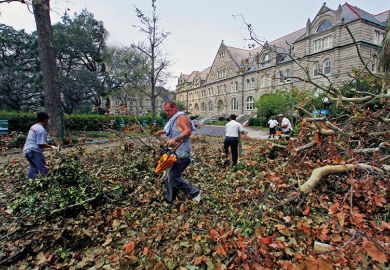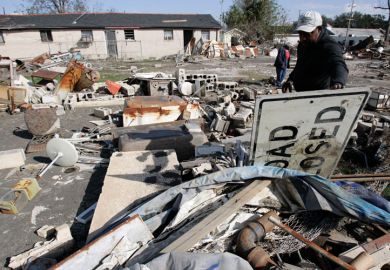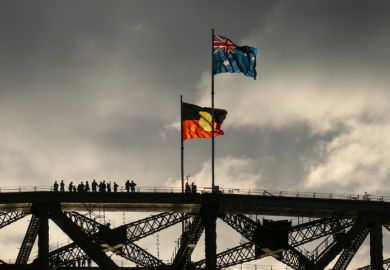Tulane University’s redevelopment of a huge former hospital building in New Orleans, abandoned since Hurricane Katrina struck, is symbolically and politically significant, and represents a stepping up of the university’s contribution to “resurrecting a jobs pipeline for the community”, according to its president.
Michael Fitts, president of the New Orleans institution, recently gave the UPP Foundation’s annual lecture in London, describing how Tulane – founded in 1834 as the Medical College of Louisiana to combat a yellow fever epidemic – had built an integral civic role during the city’s recovery from the devastation wrought by Katrina in 2005.
New Orleans’ status as a party city – the home of Mardi Gras and birthplace of jazz – means it has a big tourism and hospitality sector, “but that doesn’t create a robust jobs situation”, Professor Fitts told Times Higher Education.
After the loss of energy sector jobs, “the challenge for New Orleans is how to resurrect a jobs pipeline for the community”, added the former dean of the University of Pennsylvania’s Carey Law School.
In his speech, Professor Fitts highlighted the examples of Silicon Valley and Pittsburgh’s revival after brutal deindustrialisation as showing “the power of start-up culture to create or transform communities when paired with a major research university”.
While New Orleans has “a way to go before we join those ranks”, the Tulane Innovation Institute – aiming to bring research and breakthroughs from Tulane, other institutions and individuals across the region to market – has the “resources in place to make it happen”, Professor Fitts argued.
The Innovation Institute will eventually be housed at the redeveloped Charity Hospital building – a 20-storey art deco building in the heart of New Orleans, home to a major hospital until it suffered huge damage during Hurricane Katrina, left vacant since.
Tulane’s School of Public Health and Tropical Medicine, which was the first such school created in the US, is among the other sections of the university slated to move to the Charity site, where the university aims to foster a hub for biomedical science, innovation and start-ups.
The redevelopment “has substantive significance – it [the building] has lain dormant for 20 years – but it’s symbolically important, politically important that we’re bringing it back”, said Professor Fitts.
The “eds and meds” model – whereby universities and hospitals have become central to the economies of US cities that lost huge numbers of manufacturing jobs in deindustrialisation – is a familiar and longstanding one. The model has its limits if it doesn’t set off wider job creation and wealth beyond those institutions.
But that is a model new to New Orleans and one that can boost the city, Professor Fitts said.
“It is eds and meds, but our investment has exploded over time,” he added of the contribution to the city made by Tulane, whose key research assets lie in its medical school, public health and work on environmental issues such as coastal erosion.
“Our research funding, percentage-wise, has probably increased as much as anybody in the United States [up 50 per cent in the last five years]. So, you can see this expansion of what [the university] means for the community.”
That new research money is “funding coming into the city to support jobs and labs”, he added, arguing that investment would also eventually work through into wider economic benefits.
In a “biomedical age”, Tulane’s strengths in public health and medicine were “where a lot of the new discoveries will come”, said Professor Fitts.
Tulane’s history, he continued, has given it “a stronger connection with the city than most universities have”, being “different from other universities that were very inward-looking, very much out of the liberal arts”. But “with Katrina it [the connection with the city] was brought home front and centre”.
He added: “If we didn’t reopen, 25,000 people wouldn’t have returned to become part of the community. Our reopening was, I think, a critical moment.”
In the wake of Katrina, Tulane introduced a public service requirement for all undergraduates, the first major US research university to do so, and a move that changed the profile of the students it attracts.
Then the response to the Covid pandemic, when Tulane reopened its campus early thanks to a huge testing programme, “like Katrina, reaffirmed our commitment and relationship with the community”, Professor Fitts said.
He highlighted the fact that in a polarised US “there’s real debate about the value of higher education”.
But he added: “I do think the nature of research has changed over the last 25 years. There’s much more of an understanding of the value of the academic enterprise to the world: clinical trials, development of treatments and care…We’re very much real world-oriented to research that’s going to make a difference.”
After a pandemic in which it was clear “the research on Covid was going to save lives”, such essential work emerging from universities was, said Professor Fitts, “something that brings people together”.
Register to continue
Why register?
- Registration is free and only takes a moment
- Once registered, you can read 3 articles a month
- Sign up for our newsletter
Subscribe
Or subscribe for unlimited access to:
- Unlimited access to news, views, insights & reviews
- Digital editions
- Digital access to THE’s university and college rankings analysis
Already registered or a current subscriber?






